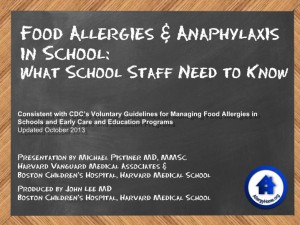 PREVIOUS MYTH:
We can't afford a full-time school nurs
PREVIOUS MYTH:
We can't afford a full-time school nurs
 NEXT MYTH:
The smell of peanut butter will cause an allergic reaction in someone with a peanut allergy
NEXT MYTH:
The smell of peanut butter will cause an allergic reaction in someone with a peanut allergy PREVIOUS MYTH:
We can't afford a full-time school nurs
PREVIOUS MYTH:
We can't afford a full-time school nurs
 NEXT MYTH:
The smell of peanut butter will cause an allergic reaction in someone with a peanut allergy
NEXT MYTH:
The smell of peanut butter will cause an allergic reaction in someone with a peanut allergy
 Staff Training: Food Allergies & Anaphylaxis in School – What School Staff Need to Know
Staff Training: Food Allergies & Anaphylaxis in School – What School Staff Need to Know
This 30 minute module is designed to assist the school nurse in staff training of management of life-threatening allergic reactions and increase food allergy awareness for all school staff including teachers, food service personnel, administrators, aides, specialists, coaches, bus drivers, custodians and others.
“You will experience a severe allergic reaction if the food that you are allergic to touches your skin.”
Healthy skin is a good barrier. Although local skin reactions do occur, isolated contact with intact skin is very unlikely to cause an anaphylactic reaction. More severe reactions can occur if the allergen then gets in the mouth, eyes or nose.
Two studies looked at the effect of skin contact with food allergen (Study 1, Study 2) . In both studies the subjects were allergic to peanut and had peanut butter placed on intact skin. Although local rash was seen in about a third of the subjects, no one experienced a full body or severe allergic reaction. Keep in mind though that if someone with a food allergy were to touch an allergen with their hand and put it in their mouth, it is as if they’re eating it. This is very relevant in young children who are exploring their environment with their hands and their mouths. Although the above is reassuring, it is always necessary to prevent skin contact with allergens. Lotions, creams, some soaps and other topical items may also contain food allergens. Reading the labels for these is important. It’s important to wash hands before rubbing eyes, or putting fingers in the mouth or nose.
All information contained on the Schools.AllergyHome.org website is intended for informational and educational purposes. The information provided on this website is not intended to be a replacement or substitute for professional medical advice. Any information that you have received from Schools.AllergyHome.org should be verified with your licensed health care provider. Furthermore, decisions regarding medical care should not be based solely upon the content of this website but made after discussions with your health care provider. Consumers should never disregard or delay seeking medical advice due to the content of this site.
Your use of this site does not create a patient-physician relationship between you and AllergyHome.org.
Medical information changes constantly. Therefore the information on this site or on the linked websites should not be considered current, complete or exhaustive, nor should you rely on such information to recommend a course of treatment for you or any other individual. Reliance on any information provided on this site or any linked websites is solely at your own risk.
Please note that AllergyHome is not affiliated with Boston Children’s Hospital